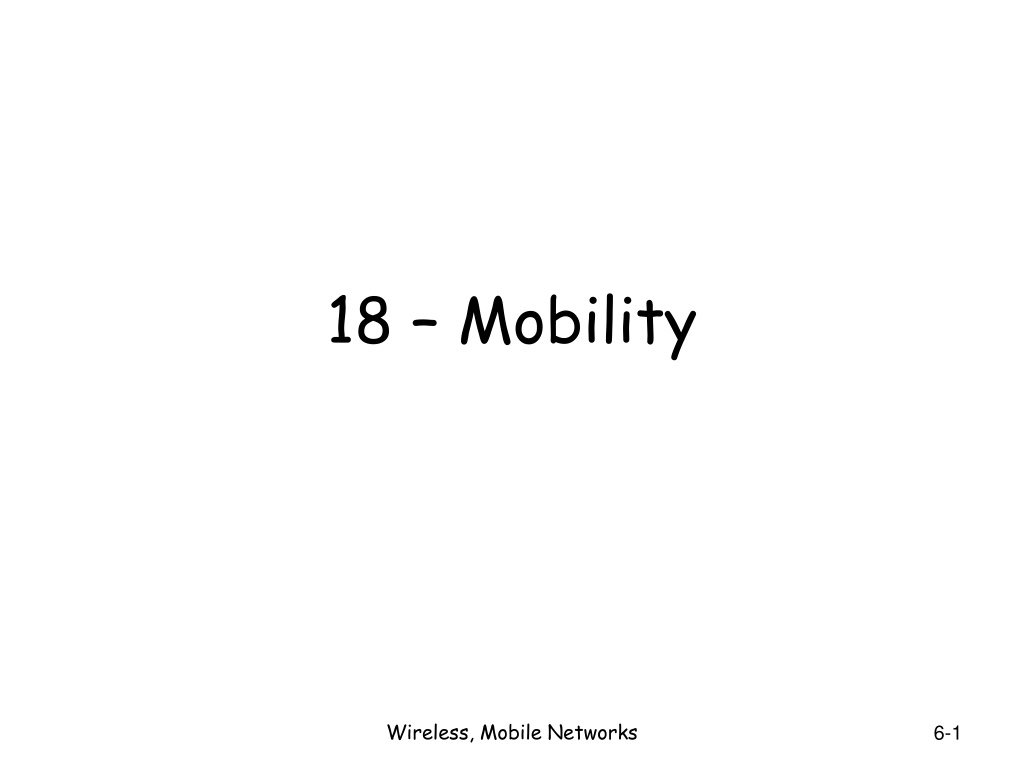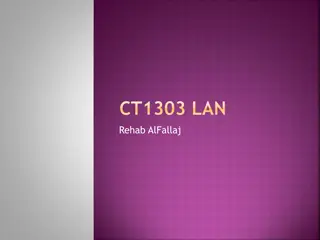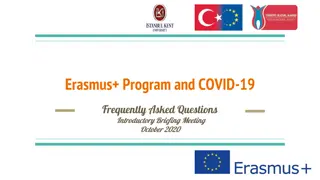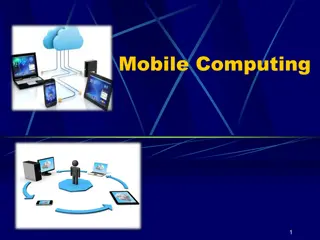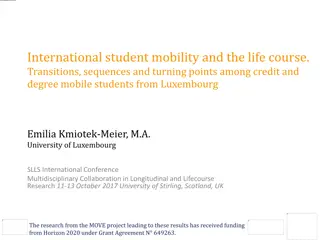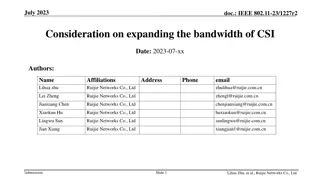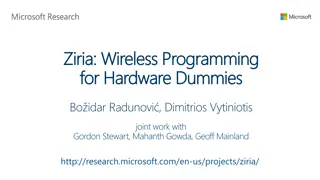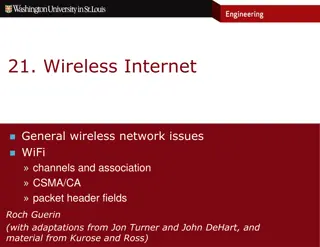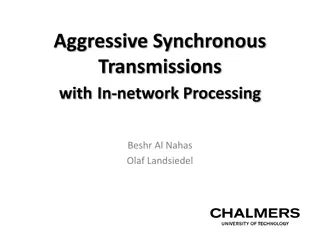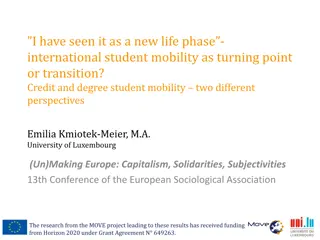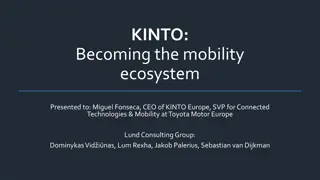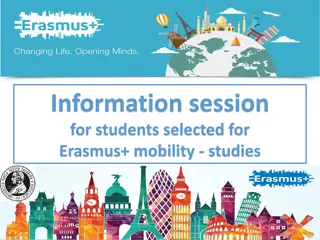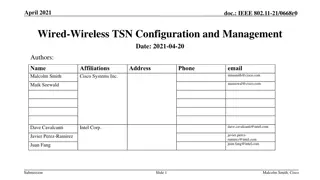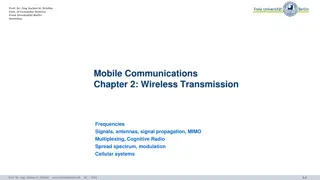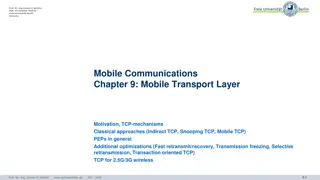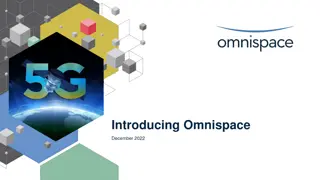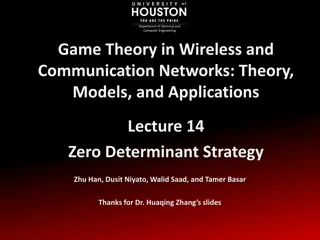Understanding Mobility in Wireless and Mobile Networks
Explore the vocabulary and approaches related to mobility in wireless and mobile networks. Understand concepts such as home network, home agent, permanent address, visited network, care-of-address, and more. Learn about different mobility approaches and the registration process in these networks.
Download Presentation

Please find below an Image/Link to download the presentation.
The content on the website is provided AS IS for your information and personal use only. It may not be sold, licensed, or shared on other websites without obtaining consent from the author. Download presentation by click this link. If you encounter any issues during the download, it is possible that the publisher has removed the file from their server.
E N D
Presentation Transcript
18 Mobility Wireless, Mobile Networks 6-1
Mobility: Vocabulary home network: permanent home of mobile (e.g., 128.119.40/24) home agent: entity that will perform mobility functions on behalf of mobile, when mobile is remote wide area network Permanent address: address in home network, can always be used to reach mobile e.g., 128.119.40.186 correspondent Wireless, Mobile Networks 6-2
Mobility: more vocabulary visited network: network in which mobile currently resides (e.g., 79.129.13/24) Permanent address: remains constant (e.g., 128.119.40.186) Care-of-address: address in visited network. (e.g., 79,129.13.2) wide area network foreign agent: entity in visited network that performs mobility functions on behalf of mobile. correspondent: wants to communicate with mobile Wireless, Mobile Networks 6-3
Mobility: approaches Let routing handle it: routers advertise permanent address of mobile-nodes-in-residence via usual routing table exchange. routing tables indicate where each mobile located no changes to end-systems Let end-systems handle it: indirect routing: communication from correspondent to mobile goes through home agent, then forwarded to remote direct routing: correspondent gets foreign address of mobile, sends directly to mobile Wireless, Mobile Networks 6-4
Mobility: approaches Let routing handle it: routers advertise permanent address of mobile-nodes-in-residence via usual routing table exchange. routing tables indicate where each mobile located no changes to end-systems let end-systems handle it: indirect routing: communication from correspondent to mobile goes through home agent, then forwarded to remote direct routing: correspondent gets foreign address of mobile, sends directly to mobile not scalable to millions of mobiles Wireless, Mobile Networks 6-5
Mobility: registration visited network home network 1 2 wide area network mobile contacts foreign agent on entering visited network foreign agent contacts home agent home: this mobile is resident in my network End result: Foreign agent knows about mobile Home agent knows location of mobile Wireless, Mobile Networks 6-6
Mobility via Indirect Routing foreign agent receives packets, forwards to mobile home agent intercepts packets, forwards to foreign agent visited network home network 3 wide area network 2 1 4 correspondent addresses packets using home address of mobile mobile replies directly to correspondent Wireless, Mobile Networks 6-7
Mobility via Direct Routing foreign agent receives packets, forwards to mobile correspondent forwards to foreign agent visited network home network 4 wide area network 2 3 4 1 correspondent requests, receives foreign address of mobile mobile replies directly to correspondent Wireless, Mobile Networks 6-8
Accommodating mobility with direct routing anchor foreign agent: FA in first visited network data always routed first to anchor FA when mobile moves: new FA arranges to have data forwarded from old FA (chaining) foreign net visited at session start anchor foreign agent wide area network 2 1 4 3 5 new foreign network correspondent agent new foreign agent correspondent Wireless, Mobile Networks 6-9
Mobile IP RFC 3344 has many features we ve seen: home agents, foreign agents, foreign-agent registration, care-of-addresses, encapsulation (packet-within-a-packet) Components in current standard: indirect routing of datagrams agent discovery registration with home agent Wireless, Mobile Networks 6-10
GSM: indirect routing to mobile home network HLR correspondent 2 home Mobile Switching Center home MSC consults HLR, gets roaming number of mobile in visited network call routed to home network 1 3 Public switched telephone network VLR Mobile Switching Center 4 home MSC sets up 2nd leg of call to MSC in visited network mobile user MSC in visited network completes call through base station to mobile visited network Wireless, Mobile Networks 6-11
GSM: handoff with common MSC Handoff goal: route call via new base station (without interruption) reasons for handoff: stronger signal to/from new BSS (continuing connectivity, less battery drain) load balance: free up channel in current BSS GSM doesn t mandate why to perform handoff (policy), only how (mechanism) handoff initiated by old BSS VLR Mobile Switching Center new old routing routing old BSS new BSS Wireless, Mobile Networks 6-12
GSM: handoff with common MSC 1. old BSS informs MSC of impending handoff, provides list of 1+ new BSSs 2. MSC sets up path (allocates resources) to new BSS 3. new BSS allocates radio channel for use by mobile 4. new BSS signals MSC, old BSS: ready 5. old BSS tells mobile: perform handoff to new BSS 6. Mobile & new BSS signal each other to activate new channel 7. mobile signals via new BSS to MSC: handoff complete. MSC reroutes call 8 MSC-old-BSS resources released VLR Mobile Switching Center 4 2 1 7 8 3 5 6 old BSS new BSS Wireless, Mobile Networks 6-13
GSM: handoff between MSCs anchor MSC: first MSC visited during call call remains routed through anchor MSC new MSCs add on to end of MSC chain as mobile moves to new MSC IS-41 allows optional path minimization step to shorten multi-MSC chain home network correspondent Home MSC anchor MSC PSTN MSC MSC MSC (a) before handoff Wireless, Mobile Networks 6-14
GSM: handoff between MSCs anchor MSC: first MSC visited during cal call remains routed through anchor MSC home network correspondent Home MSC new MSCs add on to end of MSC chain as mobile moves to new MSC anchor MSC PSTN MSC MSC MSC IS-41 allows optional path minimization step to shorten multi-MSC chain (b) after handoff Wireless, Mobile Networks 6-15
Mobility: GSM versus Mobile IP GSM element Home system Comment on GSM element Mobile IP element Home network Home agent Network to which mobile user s permanent phone number belongs Home MSC: point of contact to obtain routable address of mobile user. HLR: database in home system containing permanent phone number, profile information, current location of mobile user, subscription information Network other than home system where mobile user is currently residing Visited MSC: responsible for setting up calls to/from mobile nodes in cells associated with MSC. VLR: temporary database entry in visited system, containing subscription information for each visiting mobile user Routable address for telephone call segment between home MSC and visited MSC, visible to neither the mobile nor the correspondent. Gateway Mobile Switching Center, or home MSC . Home Location Register (HLR) Visited System Visited network Foreign agent Visited Mobile services Switching Center. Visitor Location Record (VLR) Mobile Station Roaming Number (MSRN), or roaming number Care-of- address Wireless, Mobile Networks 6-16
Wireless, mobility: impact on higher layer protocols logically, impact shouldbe minimal best effort service model remains unchanged TCP and UDP can (and do) run over wireless, mobile but performance-wise: packet loss/delay due to bit-errors (discarded packets, delays for link-layer retransmissions), and handoff TCP interprets loss as congestion, will decrease congestion window un-necessarily delay impairments for real-time traffic limited bandwidth of wireless links Wireless, Mobile Networks 6-17
